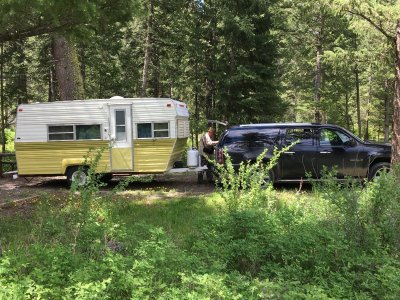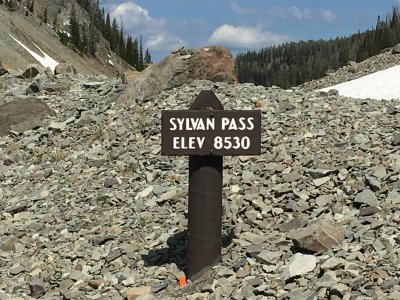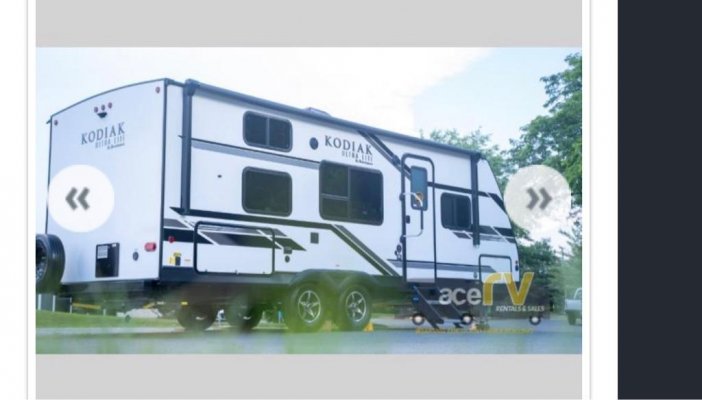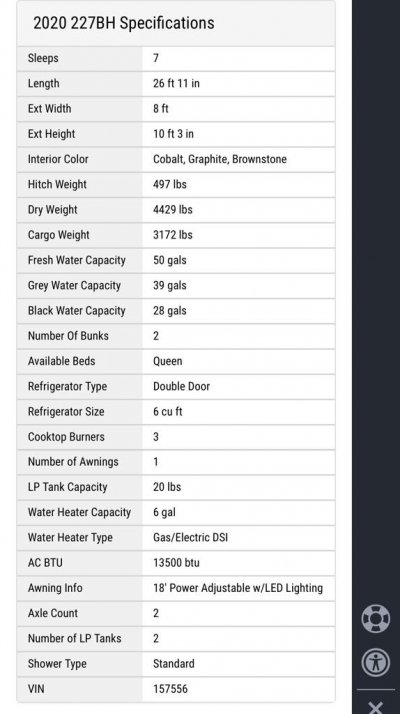RobH
Full Access Member
It sounds like a really attractive trip. Are you planning to stay east of the Mississippi River or go out west? Denver starts out a mile high and elevations go up from there.
That trailer loaded plus a family of five or six and their gear in the Tahoe would be a goodly load. Don't feel that you have to answer the following questions for me. They are just things you might consider. You may already be familiar with them.
It looks like they might be providing the hitch with the trailer rental. I would have expected a 2 5/16" trailer ball on a trailer that size and weight. Slide outs are nice. But they weigh about five hundred pounds more than the same floor plan without the slide out. Are the kids young enough for stacking them on bunk beds in a "bunkhouse" model?
The goal might be to rent a trailer with a 1000 less GVWR.
Paper plates. No one likes doing the dishes. And it uses fresh water and helps fill the grey water tank.
What is the total weight of the other members of your family besides you?
The driver, within reason, is a freebie when loading the Tahoe. As is fuel at 6 pounds per gallon. But the weight of passengers and cargo in the Tahoe are supposed to be subtracted from your max trailer weight of 8,600 pounds. It's in the fine print in the towing section of my Tahoe Owner's Manual.
How much cargo will be in the Tahoe?
And cargo in the trailer? If full, that 40 gallon fresh water tank will weigh 332 pounds.
The only way to know for sure on the weights is to weigh the total rig and then the front and rear axles of the Tahoe and the rear axles of the trailer. And compare the weights to the Front and rear axle gross weights for the Tahoe and for the trailer.
What the factory says you can tow on the level at sea level doesn't really relate to what you can do driving to the Great Smoky Mountains National Park. Or the Rocky Mountain National Park.
You might consider doing a two or three day trial run to a nearby state park in a higher elevation close by. And weigh the rig as loaded for the trip.
Don't know how many people you want in the Tahoe. Can you leave your third row seats at home?
Can you leave your second and third row seats at home and have the others drive in a second car with only a passenger (lighter) with you in the Tahoe?
For what it is worth, I figure my Tahoe LT 2WD with the NHT Max Trailering Package is good for me and my wife and things and a trailer with a max loaded weight of 5,500 pounds (12,000 combined) going over the ~ 9,000 foot passes out west.
I know that it is rated for 14,000 pounds combined weight. But I know how my brother's Yukon XL 6.2 liter with 3.42 rear axle handled pulling his older, heavy, 21 foot trailer with a claimed weight of 3,000 pounds over a 9,000 foot pass last summer on a trip to Yellowstone. The Yukon XL weighs about 400 pounds more than a Tahoe. That's why the Tahoe has a greater trailer weight rating than the long wheelbase models.

There was a little bit of huffing and puffing going on with three of us in the Yukon. And a couple of "pull over in a turn off, put it in neutral, let cars behind us pass, and let the engine and transmission cool down some". Some of the grades can be steep with long ascents.
East entrance to Yellowstone.

That trailer loaded plus a family of five or six and their gear in the Tahoe would be a goodly load. Don't feel that you have to answer the following questions for me. They are just things you might consider. You may already be familiar with them.
It looks like they might be providing the hitch with the trailer rental. I would have expected a 2 5/16" trailer ball on a trailer that size and weight. Slide outs are nice. But they weigh about five hundred pounds more than the same floor plan without the slide out. Are the kids young enough for stacking them on bunk beds in a "bunkhouse" model?
The goal might be to rent a trailer with a 1000 less GVWR.
Paper plates. No one likes doing the dishes. And it uses fresh water and helps fill the grey water tank.
What is the total weight of the other members of your family besides you?
The driver, within reason, is a freebie when loading the Tahoe. As is fuel at 6 pounds per gallon. But the weight of passengers and cargo in the Tahoe are supposed to be subtracted from your max trailer weight of 8,600 pounds. It's in the fine print in the towing section of my Tahoe Owner's Manual.
How much cargo will be in the Tahoe?
And cargo in the trailer? If full, that 40 gallon fresh water tank will weigh 332 pounds.
The only way to know for sure on the weights is to weigh the total rig and then the front and rear axles of the Tahoe and the rear axles of the trailer. And compare the weights to the Front and rear axle gross weights for the Tahoe and for the trailer.
What the factory says you can tow on the level at sea level doesn't really relate to what you can do driving to the Great Smoky Mountains National Park. Or the Rocky Mountain National Park.
You might consider doing a two or three day trial run to a nearby state park in a higher elevation close by. And weigh the rig as loaded for the trip.
Don't know how many people you want in the Tahoe. Can you leave your third row seats at home?
Can you leave your second and third row seats at home and have the others drive in a second car with only a passenger (lighter) with you in the Tahoe?
For what it is worth, I figure my Tahoe LT 2WD with the NHT Max Trailering Package is good for me and my wife and things and a trailer with a max loaded weight of 5,500 pounds (12,000 combined) going over the ~ 9,000 foot passes out west.
I know that it is rated for 14,000 pounds combined weight. But I know how my brother's Yukon XL 6.2 liter with 3.42 rear axle handled pulling his older, heavy, 21 foot trailer with a claimed weight of 3,000 pounds over a 9,000 foot pass last summer on a trip to Yellowstone. The Yukon XL weighs about 400 pounds more than a Tahoe. That's why the Tahoe has a greater trailer weight rating than the long wheelbase models.

There was a little bit of huffing and puffing going on with three of us in the Yukon. And a couple of "pull over in a turn off, put it in neutral, let cars behind us pass, and let the engine and transmission cool down some". Some of the grades can be steep with long ascents.
East entrance to Yellowstone.

Last edited:



![20200706_123918[1].jpg 20200706_123918[1].jpg](https://www.tahoeyukonforum.com/data/attachments/247/247853-e23f5b6fbaddb65e0a8e85c09ae7607f.jpg)
![20200706_123853[1].jpg 20200706_123853[1].jpg](https://www.tahoeyukonforum.com/data/attachments/247/247852-28b6cc42ed001998e03164ce04c5c31e.jpg)